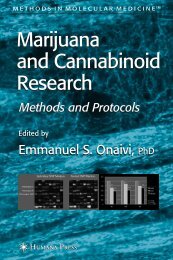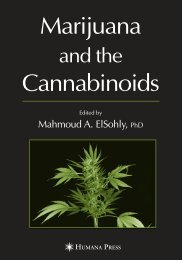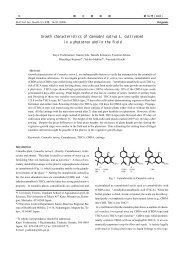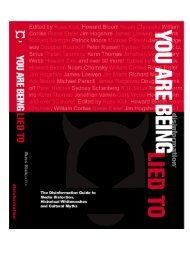Psychedelic Chemistry - Hampapartiet
Psychedelic Chemistry - Hampapartiet
Psychedelic Chemistry - Hampapartiet
- No tags were found...
Create successful ePaper yourself
Turn your PDF publications into a flip-book with our unique Google optimized e-Paper software.
file:///L:/e-books/psychedelicchemistry/chapter2.htmlreaction is observed. Add more sodium portionwise until 11.5g is in solution. To the solution at its reflux temperature, add 27.6g(0.5M) proprionitrile (or isobutyronitrile etc. for analogs) and add the resulting solution dropwise to 53.3g 1-Cl- pentane (or 0.5Manalog such as 2-Br-hexane etc.) and let the ammonia evaporate. Add ether, then water to the residue and separate the aqueous layerand extract with ether. Dry and evaporate in vacuum the combined ether solutions to give 64% yield of 2-methyl-heptanonitrile (II)(or analog). Add 34.0g (0.27M) (II) in tetrahydrofuran to the Grignard solution of (I) over 1/2 hour, heat 6 hours at 60øC andhydrolyze with 1600 ml 50% sulfuric acid, keeping the temperature below 40øC. Evaporate in vacuum the solvent and add another400 ml 50% sulfuric acid. Heat 1 hour at 95-100øC, cool, add ether, separate the aqueous layer and extract with ether. Dry andevaporate in vacuum the combined ether layers to get 71% yield 2-(3,5-dimethoxybenzoyl) heptane (III) (can distill 133-8/0.2),which can be demethylated as described for the preparation of (VII) below and possibly used to synthesize an active THC analog (ascan IV, V, or VI). 21.8g (0.082M) (III) is added dropwise (keeping the temperature at 15-20øC) to 3 molar methyl-MgBr in etherand refluxed 1 hour. Pour into a sulfuric acid-ice mix, add more sulfuric acid and stir. Separate and extract the aqueous layer withether. Wash, dry, filter and evaporate in vacuum the combined ether layers to get 2- (3,5-dimethoxyphenyl)-3-methyl- octanol (IV),which is dehydrated by mixing with anhydrous oxalic acid and heating to 130-40øC. Extract the dehydrated reaction products withbenzene to get the octenes (V). Add 25g (V), 2.5g 65% Ni on kieselguhr in dry hexane to hydrogenator and hydrogenate at 1750 psiand gradually increase the temperature to 125o C. After 3 hours, increase the pressure to 1850 psi and hold there 2 1/2 hours. filterand evaporate in vacuum to get 2-(3,5-dimethoxyphenyl)-3- methyl-octane (VI). Add 20g (0.08M) (VI) to 38% HBr in glacial aceticacid and stir and reflux for 6 hours. Pour onto ice and water, neutralize with solid sodium carbonate and extract with ether. Extractthe ether with 10% aqueous NaOH, acidify the aqueous solution with HCl, extract with ether and dry, evaporate in vacuum (candistill) to get 2- (3,5-dihydroxyphenyl)-3-methyl- octane (VII) (5-(1,2-dimethylheptyl)- resorcinol). As an alternative process forgetting from (III) to (VI), combine 64.2g (0.18M) methyltriphenylphosphonium bromide in dry benzene with 11.6g (0.18M) (in14% solution) butyllithium in benzene. Heat to 60øC and cool. 49.0g (0.176M) (III) in 40 ml dry benzene is added (keeptemperature below 40øC) and then reflux 2 hours. Cool, filter and evaporate in vacuum to get the octene, which after catalytichydrogenation as described for (V) yields (VI).5-A Alkylresorcinols Aust. J. Chem. 21,2979(1968)Mix 50g 3,5-dihydroxybenzoic acid, 250 g K2CO3, 200 ml dimethylsulfate and one liter acetone and reflux 4 hours. Remove theacetone, add one liter water and one liter ether to the residue and extract. Wash the ether extract with 2x100 ml concentratedNH4OH, 2x100 ml dilute HCl and 100 ml water and dry, evaporate in vacuum to get 48g methyl-3,5- dimethoxybenzoate (I).Recrystallize from aqueous methanol. To a stirred suspension of 19g lithium aluminium hydride in 200 ml ether add 78.4g (I) in 300ml ether at a rate which gives gentle refluxing. Reflux 2 1/2 hours, cool and add 50 ml wet ether; then 100 ml dilute sulfuric acid.Wash and dry, evaporate in vacuum the ether extract to get 62g oily 3,5- dimethoxybenzyl alcohol (II). Recrystallize from etherpentane.To a cooled stirred slurry of 15g CrO3 and 250 ml pyridine add 8.4g (II) in 25 ml pyridine and let stand 1 hour at roomtemperature. Add 60 ml methanol, let stand 2 hours, and dilute with 500 ml 5% NaOH and 500 ml ether. Extract the aqueous layerwith ether and wash the combined ether layers with 500 ml water, 3x500 ml 5% sulfuric acid, 500 ml water and 200 ml saturatedNaCl and dry, evaporate in vacuum to get 7g 3,5- dimethoxybenzaldehyde (III). Re-crystallize from ether-pentane. To a flask with adropping funnel and condenser add 0.58g Mg turnings and 10 ml ether. Add a few drops of a solution of lauryl bromide (5.7g) orequimolar amount of homolog in 15 ml ether and start reaction by adding 2 drops methyl iodide. Add the remaining bromidesolution with stirring and gentle refluxing over 15 minutes and then reflux 3 hours. Cool in an ice bath and add 3.1g (III) in 5 mlether dropwise with stirring over 45 minutes. Reflux 4 hours, cool and dilute with ice water. Wash the organic layer with 2x25 ml3N sulfuric acid, 2x25 ml 10% K2CO3, 25 ml water, 25 ml saturated NaCl and dry, evaporate in vacuum to get 5g 3,5-dimethoxyphenyldodecyl methanol (IV) or homolog. Recrystallize from methanol. Hydrogenate 4.2g (IV) in 50 ml ethyl acetatewith 5 drops concentrated sulfuric acid and 0.5g 10% Palladium-Carbon catalyst at room temperature and 5 atmospheres hydrogenfor 4 hours. Filter and evaporate in vacuum to get the aklylresorcinol dimethyl ether. Aust. J. Chem. 26,799(1973) gives a 2 stepsynthesis of 5-alkylresorcinols by condensation of beta-ketosulphones with 3,5-dimethoxybenzyl bromide and then reduction. Aust.J. Chem. 26,183(1973) gives a synthesis from 3,5- dimethoxy-N,N-dimethylbenzylamine in 7 steps (but perhaps only 4 will reach acpd. that can give an active THC analog).5-alkylresorcinols CPB 20,1574(1972)To a solution of 0.02M ethyl-á-ketocaprylate (or homolog) in 20 ml tetrahydrofuran, add 1.02g (0.02M) (53% oil) NaH with stirringand cooling and then add a solution of diketene (1.68g, 0.02M) in 20 ml tetrahydrofuran dropwise, keeping the temperature between-5 and 0øC. Stir 1 hour at this temperature and then 1 hour at room temperature. Neutralize with 10% HCl and extract with ether.Dry and evaporate in vacuum to get about 38% yield of ethyl-olivensation of beta-ketosulphones with 3,5-dimethoxybenzyl bromidefile:///L:/e-books/psychedelicchemistry/chapter2.html (13 of 14) [02.09.2007 14:38:02]






